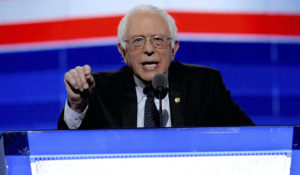Obama’s Master Class in Demagogy 101
The aim of the president’s Knox College speech on Wednesday was to wrap the economic program he has been working out with Wall Street investment bankers in democratic rhetoric. It was an exercise in political stealth.
By Michael HudsonThis piece first appeared at Michael Hudson’s website.
On Wednesday, July 25th, President Obama chose Knox College in Galesburg, Illinois (originally founded by anti-slavery activists in the 1830s) to float the economic program he has been working out with Wall Street investment bankers. His aim is to wrap this program in a democratic rhetoric. The speech’s actual content boils down to: “I’m doing fine and housing prices are recovering. The way to heal the economy faster is to make a Public-Private Partnership (with Wall Street) to finance new infrastructure investment. The government will guarantee a return – and if there’s any loss, we (you taxpayers) will bear it.” His political genius was not to sugar-coat the shady parts of his proposals.
In a Clintonesque manner, he started his speech by saying, essentially, “I feel your pain.” “In the period after World War II,” he started out, “a growing middle class was the engine of our prosperity.” People had a sense that hard work would be rewarded with fair wages and benefits, the chance to buy a home, to save for retirement, and, above all, to hand down a better life for your kids. But over time, that engine began to stall. That bargain began to fray. Technology made some jobs obsolete. Global competition sent others overseas. It became harder for unions to fight for the middle class. Washington doled out bigger tax cuts to the rich and smaller minimum wage increases for the working poor. The link between higher productivity and people’s wages and salaries was severed – the income of the top 1% nearly quadrupled from 1979 to 2007, while the typical family’s barely budged.
All true enough. The idea is that if a President can spell out how unfair the economy is, voters will imagine that he will take the next step and do something about it.
But what is the “it” that needs to be addressed. There is a tendency to blame today’s unemployment and economic stagnation on technology. Last Monday, for instance, Paul Krugman blamed much of Detroit’s problem on changing technology of auto-making. He did not mention unionization’s role – and the decision by carmakers to shift production to non-unionized sites with much lower worker benefits than the UAW had won over the years. It was as if unionized labor were itself technologically obsolete.
Nor did Obama’s setting the economic stage by focusing on global competition and technology acknowledge the role of debt in raising the price of labor. How can American industry compete when some 40% of the salaries it pays its employees must be paid for housing, 10 percent more for credit-card and other bank debt, 15% for FICA wage withholding for Social Security and Medicare, and 15% more for income tax withholding and for sales taxes? Before employees can start buying the goods and services they produce, they must spend about three-quarters of their income on the Finance, Insurance and Real Estate (FIRE) sector and taxes that have been shifted onto their shoulders?
Meanwhile, the companies themselves have been managed by financial officers whose idea of making money has been to debt-leverage, so that more and more cash flow has been used to pay back bondholders and to buy up company stock (thereby increase the value of the stock options that the managers give themselves), instead of to reinvest in expanding the business at home?
Like any good politician, President Obama recognized that if he tells people that he knows how squeezed they are, they will assume that he intends to solve the problem he has just described – not make it worth rewarding his backers.
Without mentioning that he had promised to write down the legacy of consumer debt and real estate debt, he hoped to disarm audience resentment by acknowledging that over the past “three decades, a housing bubble, credit cards, and a churning financial sector kept the economy artificially juiced up. But by the time I took office in 2009, the bubble had burst.” So it’s not his fault; he just inherited the problem.
What’s wrong with this picture? He obviously did not expect his students to remember how Democratic Congressman Barney Frank’s got Bush Treasury Secretary Hank Paulson to agree to link the $700 billion TARP subsidy to the banks to a mortgage-debt writedown. Paulson agreed to this, if President-elect Obama would sign on. He didn’t, and the proposal sank.
President Obama also did not expect the Knox College liberal arts students to have read FDIC Chairperson Sheila Bair’s Bull by the Horns or SIGTARP Neil Barofsky’s Bailout to remember how Obama’s Treasury Secretary Tim Geithner disabled any serious plan to write down mortgage debts, by explaining to Barofsky that the Home Affordable Mortgage Program (HAMP) was intended merely to “foam the runway” to slow foreclosures, not prevent them.
President Obama sought to get the debt problem behind him by acknowledging up front that it had cost “millions of Americans their jobs, their homes, and their savings. The decades-long erosion of middle-class security was laid bare for all to see and feel.” Not mentioned was how this “erosion” of security was what had produced the gains of the banks and Wall Street institutions that became his largest political campaign funders.
Now comes the hutzpah, trying to rewrite history while most people are still engulfed in it:
Together, we put in place tough new rules on big banks, and protections that cracked down on the worst practices of mortgage lenders and credit card companies. We changed a tax code too skewed in favor of the wealthiest at the expense of working families, locking in tax cuts for 98% of Americans, and asking those at the top to pay a little more. The reality, of course, the FICA wage withholding has just increased. And the president has let the crooked mortgage lenders off without prosecuting them, levying only a few pennies on the dollar of fines.
“Add it all up,” he went on, “and over the past 40 months, our businesses have created 7.2 million new jobs. This year, we are off to our strongest private-sector job growth since 1999.” Of course, job growth is not really “strong” when the jobs created are mainly in the service sector paying the minimum wage or barely above it. This is not growth. It is desperation when wage trends do not keep with the rising cost of acquiring housing, health care and obtaining an education to get work.The problem weighing down today’s economy is still the debt overhang. Households are “deleveraging,” that is, spending their income on paying down the debts they have inherited. This is what is stifling market demand, and hence new investment and employment. Obama’s speech seeks to gloss over this problem as if his failure to write down debts is no longer an issue:
Thanks to the grit and resilience of the American people, we’ve cleared away the rubble from the financial crisis and begun to lay a new foundation for stronger, more durable economic growth. In our personal lives, we tightened our belts, shed debt and refocused on the things that really matter.
But “tightened our belts” means paying down debt and thus diverting spending away from goods and services. The debt has not been “shed.” It has been paid out of salaries, reducing what is left to spend on goods and services. When the media try to assure readers and viewers that the economy is on the way to recovery, it is as if the economy can afford to resume growth without writing down the debts that were run up by 2008.
The president acknowledged that “nearly all the income gains of the past ten years have continued to flow to the top 1%.” If he can’t deny it, best to come right out to say it. After all, is this not what he and other politicians have promised their campaign contributors? That’s what politics is all about today: making sure that the gains flow to the top 1%.
The problem is, what to do about it. All this description of the problem looks like preparing the ground for what threatens to be the government’s next big giveaway: a Public-Private Partnership, based on privatizing America’s infrastructure.
We’ve got ports that aren’t ready for the new supertankers that will begin passing through the new Panama Canal in two years’ time. We’ve got more than 100,000 bridges that are old enough to qualify for Medicare. Businesses depend on our transportation systems, our power grids, our communications networks – and rebuilding them creates good-paying jobs that can’t be outsourced. And yet, as a share of our economy, we invest less in our infrastructure than we did two decades ago.
The question is, how will infrastructure be financed. The danger that is looming is a giveaway to high finance, such as we have seen in Chicago, where Goldman Sachs and other hedge funds bought the right to install tollbooths on Chicago’s sidewalks with parking meters to squeeze out revenue at the cost of raising the price of driving and transportation in the city.
Most great fortunes in history have been carved out of the public domain. That was the case with America’s colonial land grants, and the railroad land grants after the Civil War. The great question facing Europe as well as America today is whether infrastructure will be provided at a low price – which can best be achieved by public investment – or at a high price as rent-extracting owners turn roads into toll roads, bridges into toll bridges, and so on throughout the economy. This is the looming Wall Street plan, using today’s downturn as an opportunity to cloak a vast new monopoly grab as a “solution” to the economic problem rather than looming as a new threat to price American labor and industry out of global markets.
The same thing is happening in Greece and other Eurozone countries obliged to pay bondholders by selling off infrastructure. In today’s world, privatization means financialization – funding the new construction with debt-financing, building interest and dividend charges into the price of services – and making this revenue tax-free as a result of the tax deductibility of interest.
I think that Obama’s speech is seeking to “foam the runway” for this plan. One need merely look at what the City of London’s Public-Private Partnership has done to that nation’s transportation system to see a peep into what would be a dysfunctional future for this country. The plan would be for the government to guarantee returns (against cost overruns or losses), passing all losses on to “taxpayers.”
This is essentially what the President proposes to do with mortgages that are still underwater. “I’ve asked Congress to pass a good, bipartisan idea – one that was championed by Mitt Romney’s economic advisor – to give every homeowner the chance to refinance their mortgage and save thousands of dollars a year.” Under this plan the government will absorb the loss – the writedown – that otherwise would be borne by the banks and other mortgage holders. Taxpayers will foot the bill to pay Wall Street. This is the basic model for Obama’s infrastructure plan to be unveiled in the next few weeks.
So what we have in the President’s Knox College speech is an exercise in political stealth. In essence, his message is: “I know how unfair society is. Trust me.” It was what Charles Keating said to his S&L depositors. It worked for Bill Clinton. The more clearly a candidate can vocalize peoples’ desires for prosperity, upward mobility and deterrence of wrongdoing, the better they seem likely to legislate a solution. As the famous quip attributed to George Burns, Groucho Marx and others puts it: “The secret of life is sincerity and fair dealing. If you can fake that, you’ve got it made.”
The basic script is a fairy tale that balancing the budget in the face of the $13 trillion in Wall Street bailouts requires cutting back spending elsewhere in the economy. The Federal Reserve and Treasury were able to create this money for the banks, but pretend to be unable to do the same for the projected $1 trillion in Social Security deficits that may or may not materialize a generation from now. New wars in Syria and elsewhere can be funded by money creation, but not social spending programs – to say nothing of financing public infrastructure costs with public money creation rather than by recourse to Wall Street. This is the great policy asymmetry of the Obama Administration’s plans to use the economic crisis as an opportunity to cut and ultimately privatize Social Security as the capstone of a financialized Public-Private Partnership.
Here’s the problem that President Obama did not address in his speech: Today’s debt deflation and economic shrinkage are pushing federal, state and local budgets into deficit. This is forcing public spending to be cut back proportionally. That cutting will push state, local and federal budgets even further into deficit. This is why we are hearing calls to start selling off public infrastructure – to buyers who will become new customers for Wall Street investment banks.
It is the same phenomenon we are seeing in Europe. The newest economic prize is the right to buy rent-extraction rights to turn public roads into toll roads and similar rentier tollbooth installations. All this increases the cost of living and doing business, making the economy high-cost even as it is being impoverished.
That is not a solution. It bears out the classic principle that the solution to every problem tends to create new, even larger problems. Often these are unforeseen. But today’s problems in the making are all too foreseeable. What is needed is to keep translating the President’s speeches into their subtext.
Your support matters…Independent journalism is under threat and overshadowed by heavily funded mainstream media.
You can help level the playing field. Become a member.
Your tax-deductible contribution keeps us digging beneath the headlines to give you thought-provoking, investigative reporting and analysis that unearths what's really happening- without compromise.
Give today to support our courageous, independent journalists.






You need to be a supporter to comment.
There are currently no responses to this article.
Be the first to respond.